|
Saint Seiya
, also known as ''Saint Seiya: Knights of the Zodiac'' or simply ''Knights of the Zodiac'' (translated from the French title ''Les Chevaliers du Zodiaque''), is a Japanese manga series written and illustrated by Masami Kurumada. It was serialized in Shueisha's manga magazine ''Weekly Shōnen Jump'' from 1985 to 1990, with its chapters collected in 28 volumes. In North America, the manga was licensed for English release by Viz Media. The story follows five mystical warriors called the Saints who fight wearing sacred sets of armor named "Cloths", the designs of which derive from the various constellations the characters have adopted as their destined guardian symbols. The Saints have sworn to defend the reincarnation of the Olympian goddess Athena in her battle against other gods who want to dominate Earth. The manga was adapted by Toei Animation into a 114-episode anime television series broadcast on TV Asahi from 1986 to 1989. The anime series was followed by a ... [...More Info...] [...Related Items...] OR: [Wikipedia] [Google] [Baidu] |
Tankōbon
A is a standard publishing format for books in Japan, alongside other formats such as ''shinsho'' (17x11 cm paperback books) and ''bunkobon''. Used as a loanword in English, the term specifically refers to a printed collection of a manga that was previously published in a serialized format. Manga typically contain a handful of chapters, and may collect multiple volumes as a series continues publication. Major publishing Imprint (trade name), imprints for of manga include Jump Comics (for serials in Shueisha's ''Weekly Shōnen Jump'' and other Jump (magazine line), ''Jump'' magazines), Kodansha's Weekly Shōnen Magazine, Shōnen Magazine Comics, Shogakukan's Shōnen Sunday Comics, and Akita Shoten’s Weekly Shōnen Champion, Shōnen Champion Comics. Manga Increasingly after 1959, manga came to be published in thick, phone book, phone-book-sized weekly or monthly anthology list of manga magazines, manga magazines (such as ''Weekly Shōnen Magazine'' or ''Weekly Shōnen Jump ... [...More Info...] [...Related Items...] OR: [Wikipedia] [Google] [Baidu] |
TV Asahi
JOEX-DTV (channel 5), branded as , and better known as , is a Japanese television station serving the Kanto region as the flagship station of the All-Nippon News Network. It is owned-and-operated by the a subsidiary of , itself controlled by The Asahi Shimbun Company. Its studios are located in Roppongi, Minato, Tokyo. TV Asahi is one of the "Big Six" broadcasters based in Tokyo, alongside Nippon Television, TBS, TV Tokyo, NHK General TV, and Fuji Television. History Pre-launch After NHK General TV, Nippon TV, and TBS TV were launched in 1953 and 1955, TV has become an important medium in Japan. However, most of the programs that were aired at that time were vulgar which caused well-known critic Sōichi Ōya to mention in a program that TV made people in Japan "a nation of 100 million idiots"; those criticisms already gave birth to the idea of opening an education-focused TV station. On February 17, 1956, the Ministry of Posts and Telecommunications issued freq ... [...More Info...] [...Related Items...] OR: [Wikipedia] [Google] [Baidu] |
The Lost Canvas
, also known as simply ''The Lost Canvas'', is a Japanese manga series written and illustrated by Shiori Teshirogi. It is a spin-off based on the manga series ''Saint Seiya'', which was created, written and illustrated by Japanese author Masami Kurumada. ''The Lost Canvas'' was published by Akita Shoten in the ''Weekly Shōnen Champion'' magazine since August 24, 2006, concluding after 223 chapters on April 6, 2011, with twenty-five ''tankōbon'' released. The story takes place in the 18th century, and focuses on an orphan known as Tenma who becomes one of the goddess Athena's 88 warriors known as Saints and finds himself in a war fighting against his best friend Alone who is revealed to be the reincarnation of Athena's biggest enemy, the Underworld God Hades. The manga ''The Lost Canvas'' originated when Shiori Teshirogi's works attracted the attention of ''Saint Seiya'' author Masami Kurumada who gave her permission to write a prequel to his work while he was also writing ... [...More Info...] [...Related Items...] OR: [Wikipedia] [Google] [Baidu] |
Saint Seiya Episode
In Christian belief, a saint is a person who is recognized as having an exceptional degree of holiness, likeness, or closeness to God. However, the use of the term ''saint'' depends on the context and denomination. In Anglican, Oriental Orthodox, and Lutheran doctrine, all of their faithful deceased in Heaven are considered to be saints, but a selected few are considered worthy of greater honor or emulation. Official ecclesiastical recognition, and veneration, is conferred on some denominational saints through the process of canonization in the Catholic Church or glorification in the Eastern Orthodox Church after their approval. In many Protestant denominations, and following from Pauline usage, ''saint'' refers broadly to any holy Christian, without special recognition or selection. While the English word ''saint'' (deriving from the Latin ) originated in Christianity, History of religion, historians of religion tend to use the appellation "in a more general way to refer to t ... [...More Info...] [...Related Items...] OR: [Wikipedia] [Google] [Baidu] |
Next Dimension
NeXT, Inc. (later NeXT Computer, Inc. and NeXT Software, Inc.) was an American technology company headquartered in Redwood City, California that specialized in computer workstations for higher education and business markets, and later developed web software. It was founded in 1985 by CEO Steve Jobs, the Apple Computer co-founder who had been forcibly removed from Apple that year. NeXT debuted with the NeXT Computer in 1988, and released the NeXTcube and smaller NeXTstation in 1990. The series had relatively limited sales, with only about 50,000 total units shipped. Nevertheless, the object-oriented programming and graphical user interface were highly influential trendsetters of computer innovation. NeXT partnered with Sun Microsystems to create a programming environment called OpenStep, which decoupled the NeXTSTEP operating system's application layer to host it on third-party operating systems. In 1993, NeXT withdrew from the hardware industry to concentrate on marketing OPEN ... [...More Info...] [...Related Items...] OR: [Wikipedia] [Google] [Baidu] |

